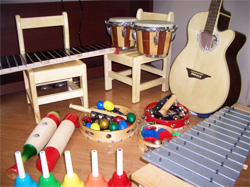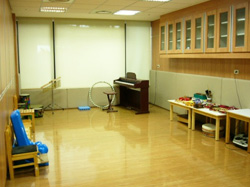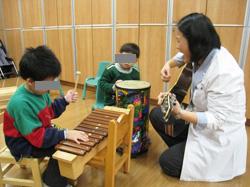Music Therapy
Music therapy is a health profession in which a music therapist uses music and its facets – physical, emotional, mental, social, aesthetic, and spiritual, to help patients improve and maintain their health. It is regarded as an expressive therapy. The cognitive function, motor skills, emotional and affective development, behavior and social skills, and quality of life of the patients are clinically proven to be improved through music therapy. Music experiences of free improvisation, singing, songwriting, listening to the music, and discussing music are believed to achieve treatment goals and objectives. The effectiveness of music therapy has been evidence based proven and is considered as both art and science. Music therapy is used in some medical hospitals, cancer centers, schools, alcohol and drug recovery programs, psychiatric hospitals, and correctional facilities.
Music therapy can be applied in all age groups and in the treatment of different disease entities. In children, two common approaches are used: either as a one-on-one session or in a group setting. Music therapy can help children with communication, attention, motivation, and behavioral problems. Therapy rooms should have a wide range of different instruments and the environment should be colorful and have different textures. The therapist should either play a piano or guitar to keep everything grounded and in rhythm. As some children will be able to handle an instrument while others cannot, the child should be given an instrument adapted to them. In Chang Gung Memorial Hospital, we have well equipped music therapy rooms as mentioned above in all three hospital branches of Taipei, Linkou, and Taoyuan.

Our music therapy room is equipped with wide range of different instruments.

Our therapy room has adequate lighting and a great environment for the needed children to receive music therapy.

Our experienced and capable music therapist plays the guitar while the lovely children play back rhythmically with their own musical instruments.
Music therapy has been shown to be an effective therapy strategy for stroke patients. Music affects different portions of the brain. Part of this therapy is the ability of music to affect emotions and social interactions. It has been proven that music therapy is associated with a decrease in depression, improved mood, and a reduction in state anxiety. Music therapy can have a positive effect on social and behavioral outcomes as well as encouraging trends with respect to mood. Over the years, our music therapy has great success in treating children with autism and adults with stroke, effectively improving their cognitive function, attention span, and life quality.
Music therapy is not covered by the National Health Insurance. The costs to receive music therapy are as follows:
- Individual one-on-one session:
- NTD 700 per 30 minutes.
- NTD 850 per 40 minutes.
- Group session:
- NTD 500 per person per 30 minutes.
- NTD 600 per person per 40 minutes.
We have two experienced and capable music therapists:
Ms. Peng, Yu-Hsiang Peng and Ms. Chao-Wen Yang
Music therapy service is available in all three Chang Gung Memorial Hospital branches of Taipei, Linkou, and Taoyuan.
- In Taipei, music therapy room is located on the 7th floor of the front building. The contact phone number is +886-2-2713-5211 ext. 3086.
- In Linkou, music therapy room is located on the 3rd floor of building B. The contact phone number is +886-3-328-1200 ext. 8149.
- In Taoyuan, music therapy room is located on the 2nd floor of the south building. The contact phone number is +886-3-319-6200 ext. 2374.
For further inquiries, please email us at yuhsiang.peng@gmail.com
References:
1. CHU, H., YANG, C. Y., LIN, Y., OU, K. L., LEE, T. Y., O'BRIEN, A. P. & CHOU, K. R. 2013. The Impact of Group Music Therapy on Depression and Cognition in Elderly Persons With Dementia: A Randomized Controlled Study. Biol Res Nurs.
2. BROWN, L. S. & JELLISON, J. A. 2012. Music research with children and youth with disabilities and typically developing peers: a systematic review. J Music Ther, 49, 335-64.
3. HARDY, M. W. & LAGASSE, A. B. 2013. Rhythm, movement, and autism: using rhythmic rehabilitation research as a model for autism. Front Integr Neurosci, 7, 19.
4. RAGLIO, A., BELLANDI, D., BAIARDI, P., GIANOTTI, M., UBEZIO, M. C. & GRANIERI, E. 2013. Listening to music and active music therapy in behavioral disturbances in dementia: a crossover study. J Am Geriatr Soc, 61, 645-7.
5. VILLENEUVE, M. & LAMONTAGNE, A. 2013. Playing piano can improve upper extremity function after stroke: case studies. Stroke Res Treat, 2013, 159105.